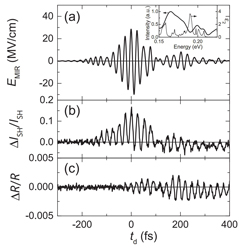Ultrafast Control of a Ferroelectricity with Dynamic Repositioning of Proton in a Supermolecular Cocrystal
T. Umanodan, Y. Okimoto, and J. Itatani
Recent progress of intense THz and mid-IR (MIR) sources has opened a new opportunity in solid state physics. The small photon energy that is associated to long wavelength enables to nondestructively apply intense optical fields (~10 MV/cm or higher) to condensed matters because multiphoton ionization followed by catastrophic optical damage is unlikely to occur. When materials, especially crystalline materials, are exposed to such intense optical fields, many nontrivial exotic phenomena (e.g., high harmonic generation in solids) start to occur.

Fig. 1. (a) Waveform of the MIR pulse used for photoexcitation. The inset depicts the power spectrum of the pulse. The thin line shows the ε2 spectrum of Hdppz-Hca. (b) and (c) Time profile of ΔISH/ISH (b) and relative change in the reflectivity (ΔR/R) (c) in the presence of a MIR field.
In this work, we explored the possibility of ultrafast control of ferroelectricity in a supraziramolecular ferroelectric cocrystal composed of protonated 2,3-di(2-pyridinyl)pyrazine (Hdppz) and deprotonated chloranilic acid (Hca). The crystal becomes ferroelectric due to proton ordering below the Curie point (Tc = 402 K), where the protons take two stable positions between the Hdppz and Hca molecules. We used intense THz and MIR pulses with stable carrier envelope phases, and probed the symmetry breaking in the presence of optical field using 6.5-fs optical pulses. This pulse duration is shorter than one oscillation period of the driving low frequency field, which allows to look into field-induced proton dynamics on sub-cycle time scales of the MIR field. We measured second harmonic of ultrashort visible pulses as a signature of inversion symmetry breaking due to proton displacement.
Figure 1(a) and (b) show the electric field waveform of the intense MIR pulses and observed change of second harmonic (SH) signals, respectively. Although the MIR field contains multiple cycles (i.e., the envelopes of the positive and negative polarity are identical), observed SH signal follows the optical waveform of the positive polarity alone. This behavior is well reproduced by a classical model depicted in Fig. 2. In this model, we included anharmonic potential and molecular vibration whose resonant frequency is within the MIR spectrum. As shown in the inset in Fig. (a)), the spectrum of driving MIR pulse has an overlap with an absorption peak of C-O- stretching mode, leading to the displacement of equilibrium point in the presence of MIR fields. Contrary, with an intense THz field, the change of SH signals was observed to be proportional to the instantaneous field amplitude.
In summary, using intense THz and MIR pulses, we observed field-induced symmetry breaking in Hdppz-Hca molecular crystals. This process can be understood as the proton displacement that can follow the oscillating optical field up to ~100 THz. The results suggest that repositioning of protons and resulting ferroelectricity can be dynamically controlled by the optical waveform of intense optical pulses. We expect that more exotic nonlinear responses will be discovered in future, leading to a foundation of PHz optoelectronics.
References
- [1] T. Umanodan, K. Kaneshima, K. Takeuchi, N. Ishii, J. Itatani, H. Hirori, Y. Sanari, K. Tanaka, Y. Kanemitsu, T. Ishikawa, S. Koshihara, S. Horiuchi, and Y. Okimoto, J. Phys. Soc. Jpn. 88, 013705 (2019). [Selected as an Editors’ Choice]
